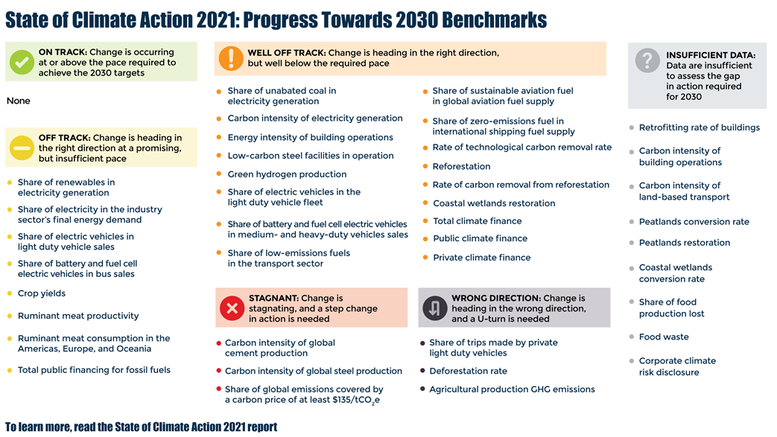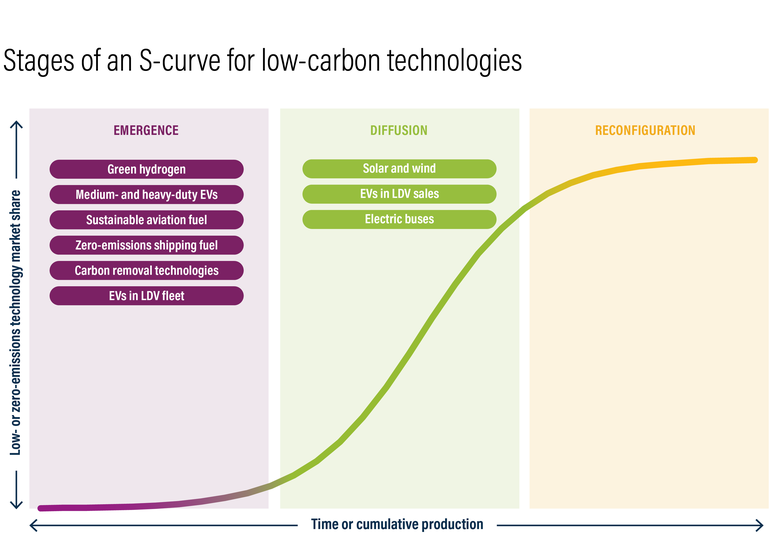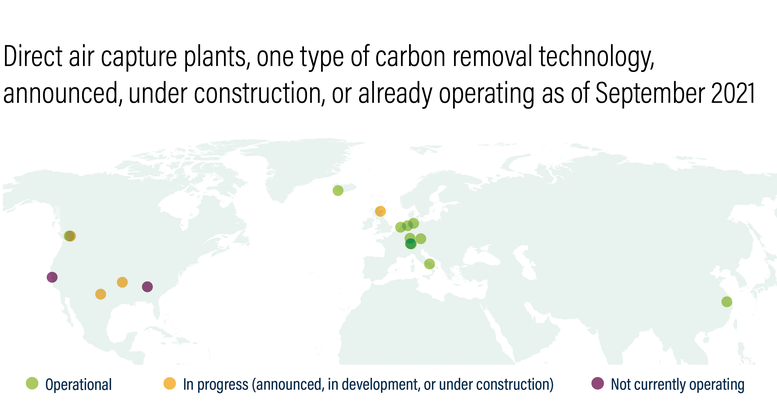We’re Not on Track for 1.5 Degrees C. What Will it Take?
By: Sophie Boehm (WRI), Katie Lebling (WRI), Kelly Levin (Bezos Earth Fund), Hanna Fekete (NewClimate Institute), Rich Waite (WRI), Anna Nilsson (NewClimate Institute), Ryan Wilson (Climate Analytics), Andreas Geiges (Climate Analytics), Joel Jaeger (WRI) and Dan Plechaty (ClimateWorks Foundation).
Summary
This decade is our make-or-break opportunity to avoid the most devastating impacts of climate change and steer the world towards a net-zero future.
It is still possible to limit global warming to 1.5 degrees C (2.7 degrees F), according to the latest report from the Intergovernmental Panel on Climate Change. But it will require rapid, far-reaching transformations across every sector — from power, buildings, industry and transport to land-use, coastal zone management and agriculture — as well as the immediate scale-up of carbon removal and climate finance.
A new report, the State of Climate Action 2021, looks at whether we are doing enough to achieve the Paris Agreement’s goals. It translates the transformations required to keep global temperature rise to 1.5 degrees C into 40 indicators of progress, with targets for 2030 and 2050 — such as rapidly phasing out unabated coal in electricity generation, effectively halting deforestation, and scaling up both public and private climate finance. The report assesses recent global progress towards these goals and identifies critical gaps in action.
It finds that, to date, none of the 40 indicators assessed are on track to reach 2030 targets. The encouraging news is that we’re not starting from a standstill — the majority of indicators (25) are moving in the right direction, albeit too slowly. Of the remaining 15 indicators, recent progress has stagnated for three, change is heading in the wrong direction entirely for another three, and the remaining nine lack sufficient data to assess progress.

Importantly, many of the indicators assessed are interconnected, so progress made toward one can further (or hinder) progress on others. Electrifying the transport sector, buildings, and industrial processes like steel and cement production, for example, all depend, in part, on decarbonizing the grid through coal phaseout and increasing the share of renewables in electricity generation. Similarly, increases in climate finance are needed across the board — achievements of all targets hinge on greater investment in ambitious climate action.
Here’s a snapshot of what we found for several of the indicators assessed:
Where Climate Action Progressing at a Promising, yet Insufficient Pace
The last five years have seen progress unfold at a promising pace for eight indicators — including the share of renewables in electricity generation, the proportion of electric vehicles in new car sales, and crop yields. But in order to reach 2030 targets, aligned with a 1.5 degrees C pathway, these rates of change need to almost double.
There are encouraging signs of progress, spurred on by a diverse portfolio of supportive measures, from corporate commitments to manufacture electric vehicles to solar and wind subsidies. Together, these actions have enabled significant increases in the share of renewables in electricity generation, electric vehicles in new car sales and battery electric vehicles in bus sales — and much faster than analysts have predicted. And although adoption rates of these three low-emissions technologies are currently below the levels required for a net-zero future, evidence from past transitions suggests that faster-than-expected gains are possible.
Such progress is possible because adoption of new technologies often follow an S-curve: Initial uptake is quite low, but as technologies’ performance improves and their price falls, these innovations begin to diffuse rapidly across society; rates of adoption accelerate as positive, self-amplifying feedbacks — such as economies of scale or the advent and adoption of complementary technologies — kick in to help reinforce change. Eventually, growth in market share slows down as adoption nears a saturation point.

Even when innovative technologies are beginning to take off, there is no guarantee they will follow an S-curve. To accelerate the uptake of solar and wind power, electric vehicles and electric buses, they will need to be nurtured with the right support at the right time — from ramping up investments in complementary technologies (such as batteries for electric vehicles) to adopting policies that incentivize adoption of these new innovations, while also discouraging the continued use of existing high-carbon technologies.
When paired with formalized laws and regulations, for example, government targets to phase out the internal combustion engine can send a strong signal to car manufacturers and consumers, and have already helped support EV adoption in the United States and Europe.

Recent progress is also unfolding at a promising pace within in the agriculture sector, where meeting a growing population’s food demand, halting deforestation, and dramatically increasing reforestation will depend on improving land-use efficiency even in a changing climate. While we have witnessed recent increases in crop yields globally, progress must occur 1.9 times faster over the next decade. Annual gains in ruminant meat productivity per hectare must also accelerate by a factor of 1.6. And even greater improvements will be needed in sub-Saharan Africa, where intensifying climate impacts threaten to depress yields that are already well below world averages.

A near doubling of the pace of action will require decision-makers across all corners of society to deploy the many tools at their disposal to accelerate progress. Key supportive measures include significant investments in new technologies to improve crop breeding and new approaches to enhance soil and water management, expansion of agricultural extension programs to provide technical assistance to farmers and policy reforms to encourage smallholders to invest in productivity improvements by securing their land rights.
Where Recent Change is Heading in the Right Direction, But Must Go at least Twice as Fast
For another 17 indicators — from green hydrogen production to reforestation — change is heading in the right direction, but recent rates of progress must at least double to achieve 2030 targets. And for many, the level of acceleration required is significantly higher. For example, in addition to dramatically reducing the conversion of land, we must also restore large areas of natural ecosystems — and much more quickly than we have been to date. Reforestation and coastal wetlands restoration must accelerate threefold to regain 259 million hectares of forests and restore 7 million hectares of mangrove forests, seagrass meadows and salt marshes by 2030.
Achieving both targets could enable these ecosystems to begin sequestering 3.2 gigatonnes of carbon dioxide (GtCO2) per year — roughly equivalent to India’s GHG emissions (excluding land-use change forestry). But delivering these targets will require decision-makers to overcome a range of political and economic barriers by, for example, adopting policies that reduce competing pressures on land, clarifying tenure regimes and simplifying processes to secure land rights, strengthening institutions to improve enforcement of existing protections, and increasing public and private finance for restoration.
Of these indicators categorized as well off track, another six closely follow low-carbon technologies that have the potential to experience exponential growth along an S-curve — such as sustainable aviation fuel or zero-emissions fuel for shipping. But all are still within the emergence phase, where high costs, uneven performance and a lack of complementary technologies make it difficult for these innovations to compete with existing technologies.
For example, along with increasing carbon removal through the reforestation and coastal wetlands restoration, a suite of technological carbon removal solutions will also need to scale up rapidly over this decade to sequester and permanently store 75 million tonnes of carbon dioxide (MtCO2) per year (roughly equivalent to Austria’s annual GHG emissions) by 2030 and 4.5 GtCO2 per year by 2050 (roughly equivalent to the combined annual GHG emissions of the European Union and Japan). Today, these technologies remove less than 1 MtCO2 per year, but investments and interest are rapidly growing, particularly in the U.S. and Europe.

To accelerate the development of these technologies, policymakers must focus on improving performance and bringing down costs. Scaling up investments in research, development and demonstration projects, expanding complementary infrastructure like renewable power capacity to meet energy needs sustainably and creating new markets for products made from captured CO2 can all help increase the deployment of these carbon removal technologies.
Where Progress is at a Standstill — or Headed in the Wrong Direction Altogether
While progress for the majority of indicators is heading in the right direction, albeit falling short of a Paris-aligned trajectory, for some indicators it is at a standstill, or, worse yet, headed in the wrong direction.
For example, for a 1.5 degrees C-compatible pathway, the amount of carbon dioxide emitted per ton of steel produced (the carbon intensity of steel) will need to decline 25-30% below 2015 levels by 2030. But from 2010 and 2019, the carbon intensity of steel fluctuated, resulting in a slight overall increase. A range of strategies, including increasing the uptake of new technologies powered by electricity, improving energy efficiency, and producing steel using green hydrogen, can help jumpstart progress across the steel industry.
Even more troubling is that change for some indicators needs to see a sharp U-turn in action. The rate of deforestation, for instance, must decline 70% by 2030, relative to 2018. Instead, annual deforestation and associated emissions have risen since 2010. Efforts to reduce forest loss are hampered by a number of economic and political barriers: The growing demand for commodities like beef, soy and palm oil incentivize forest conversion; limited finance for conservation hampers efforts to protect forests; and insecure land rights leave forests managed by Indigenous Peoples and local communities vulnerable.

Managing the Transition to a Net-Zero Future
Achieving these global targets by 2030 will require significant financial investments, technology transfer and capacity-building — especially for developing countries. While climate finance continues to increase, it remains far from sufficient. The State of Climate Action 2021 report finds that $5 trillion will be needed annually by 2030 to finance the systemwide transformations needed to limit global warming to 1.5 degrees C. But to meet this target, annual increases in total funding from public and private sources must accelerate by a factor of 13.
Fortunately, investing in a net-zero future can create enormous social and economic benefits, particularly for communities already contending with intensifying climate impacts. But equitably distributing these gains will require governments to adopt measures that help ensure this transition is just, especially for workers currently tied to a carbon-intensive future.
Our ever-shrinking carbon budget does not accommodate delay. Should we fail to act now and greenhouse gas emissions continue to rise unabated, warming could climb to between 3.3 degrees C and 5.7 degrees C (5.9 degrees F and 10 degrees F) above preindustrial levels by 2100 — temperatures that would intensify the catastrophic impacts far beyond anything seen so far.
But if we can make a true step-change in ambition and action, as we’re beginning to see in some corners of the world, at COP26 and beyond, we can bring the enormous task of holding global temperature rise to 1.5 degrees C within reach and secure a safer, more prosperous and equitable future for all.
Links
This blog is cross-posted here and on the WRI website.
Stay informed
Subscribe to our newsletter